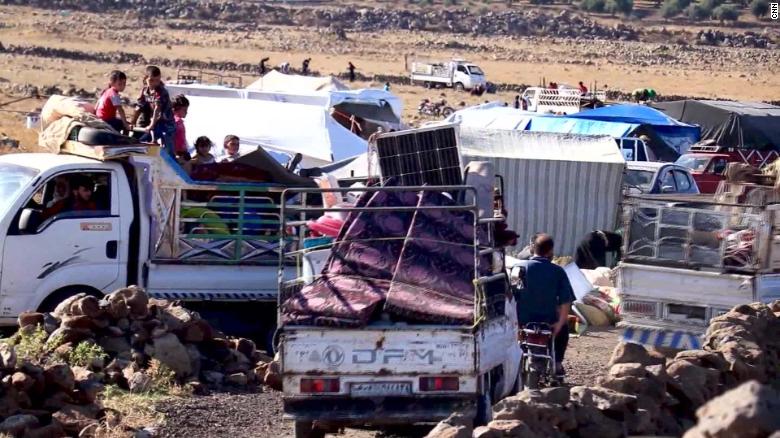(CNN)Syrian government forces say they have retaken a town that was the epicenter of the civil war that engulfed the country and the region for more than seven years.
State media said the Syrian troops entered the town of Dara'a on Thursday.
Under an agreement reached last week with militant groups, the Syrian government said "terrorist groups will hand over heavy and medium weapons," and that those who agree to the accord will be permitted to remain in the area.
"Those who refuse reconciliation will be evacuated," the state-run SANA news agency reported Thursday.
Troops raised the Syrian flag once again over the town of Dara'a, where graffiti taunting Syrian President Bashar al-Assad about the demise of Arab dictators in other countries first sparked the uprising that became the Syrian war.
Syria's war origin story
For many Syrians, the war began in the town of Dara'a, an agricultural town on the border with Jordan. In March 2011, 15 teenage boys were arrested because of graffiti spray-painted on a high school wall.
The images of Arab strongmen like Egypt's Hosni Mubarak and Tunisia's Ben Ali abdicating power prompted someone to scrawl on the wall: 'It's your turn now Doctor,' referring to Assad, the ophthalmologist.
Town officials couldn't find the perpetrator. The boys were held, beaten, had fingernails removed, and were tortured for weeks in a bid to prise a confession out of them.
While they were captive, their town revolted, protesting daily and calling on Assad to pressure the town's police chief to release them.
Weeks later they were finally freed, and Dara'a had become a focal point in the government's effort to suppress unrest. By the spring of 2011, army tanks rolled into the town, rebel forces took up positions to fight the army, and the town and the surrounding areas, descended into unrelenting violence.
Over seven years later, with millions of Syrians displaced and hundreds of thousands dead, the final push into Dara'a seemingly puts an end to the war as Syrian and Russian forces wrap up a major offensive launched last month.
Hundreds of thousands homeless
More than 300,000 Syrians were made homeless by the regime's latest offensive in Dara'a, south of Damascus. Many have headed to the borders with Jordan and the Israeli-occupied Golan Heights, but neither country is willing to accept them.
UNICEF spokeswoman Juliette Touma told CNN last week that it was the largest displacement of civilians in southern Syria since the war began. In three weeks of fighting, some 180,000 children were forced from their homes.
On Thursday, the World Health Organization called for urgent access to displaced civilians in southern Syria for the delivery of medicines and medical items.
Tens of thousands are facing high temperatures, dusty desert winds and limited access to drinking water and sanitation services. In the past week, at least 15 Syrians, including 12 children, have died due to dehydration and diseases transmitted through contaminated water, WHO said.
Earlier this week, UN High Commissioner for Refugees Filippo Grandi described the conditions for displaced people in southwest Syria as "dire and insecure" and called for Jordan to grant temporary refuge to those in need of safety.
The Jordanian government is refusing to allow Syrian refugees across the border, saying that the resource-poor kingdom has reached capacity.
What has happened in Dara'a mirrors other advances by the regime since the fall of Aleppo at the beginning of 2017. One by one, areas that were agreed to be "de-escalation zones" have come under attack by Assad's army and pro-regime militias, backed by Russian airpower. Once rebel groups are weakened, the Russians step in to stabilize the area.
Syrian army engineering units would now sweep residential neighborhoods to prepare for "the entry of the workshops to rehabilitate infrastructure and restore basic services to Dara'a," state media reported.
"With the Syrian army entering the area, another chapter of terrorists' crimes comes to an end," it added.








